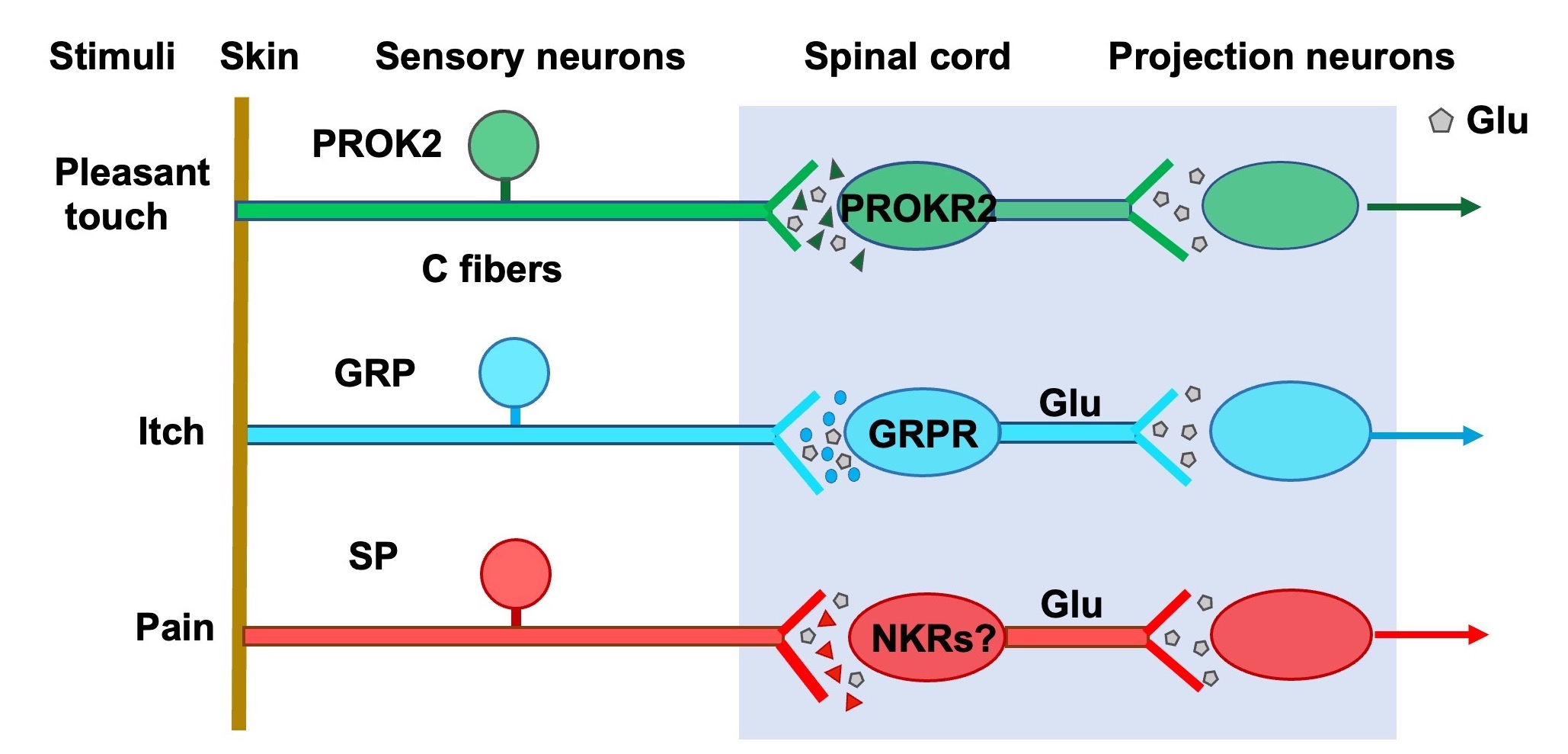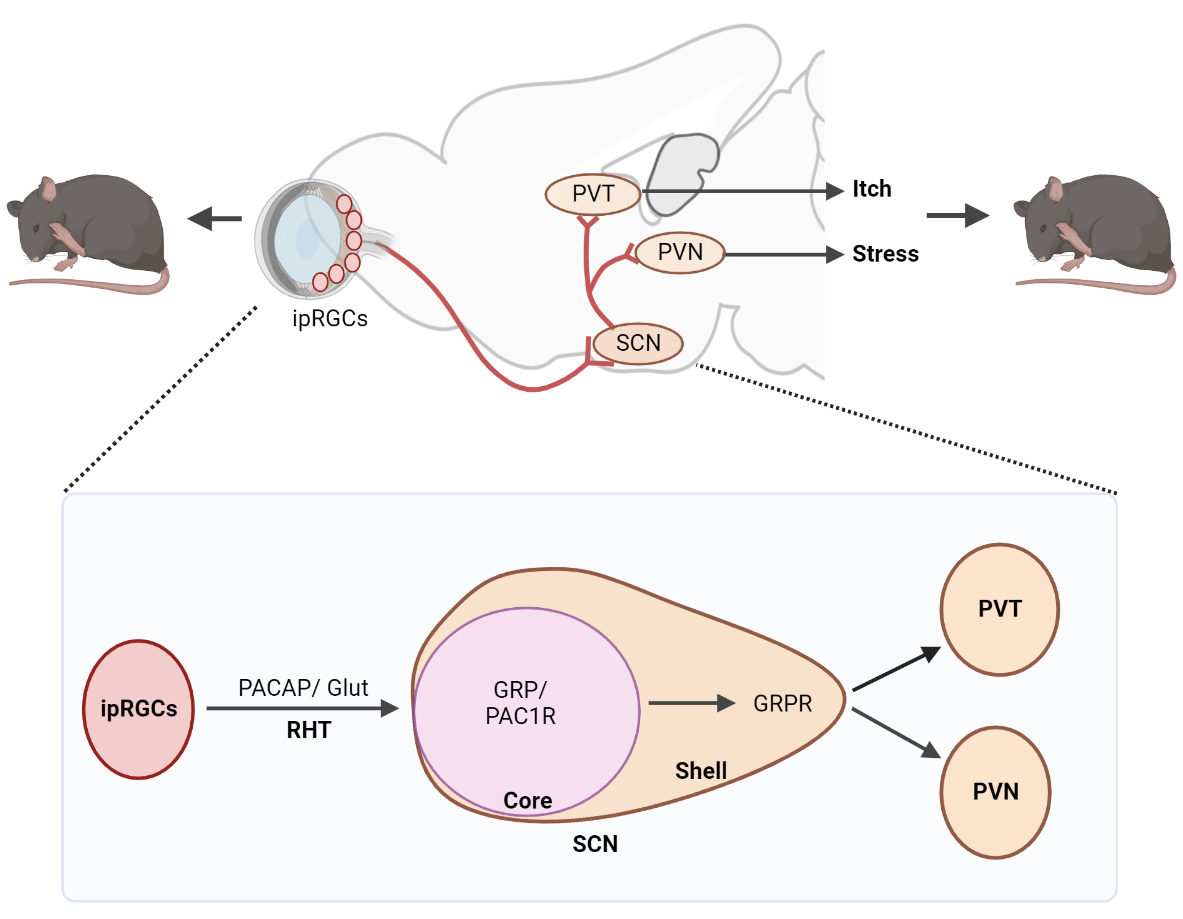
Somewhere, something incredible is waiting to be known.
Chen, Zhou-Feng
陈宙峰
Institute of Neurological and Psychiatric Disorders
Senior Principal Investigator
chenz@szbl.ac.cn
Timeline
-
2023-Present
Shenzhen Bay Laboratory Senior Principal Investigator
-
2011-2023
Center for the Study of Itch and Sensory Disorders, Washington University School of Medicine, MO, USA. Director
-
2000-2023
Washington University School of Medicine, MO, USA. Assistant Professor, Associate Professor, Professor
-
1998-2000
California Institute of Technology, CA, USA. Senior Research Fellow
-
1994-1998
Howard Hughes Medical Institute, California Institute of Technology, CA, USA. Postdoctoral Fellow
-
1990-1994
University of Texas Health Science Center at Houston, USA. Ph.D. in Genetics
-
1983-1990
National Vaccine & Serum Institute, Beijing, China Assistant Research Fellow
-
1986-1987
London School of Hygiene & Tropical Medicine, London University, England Visiting Scholar
-
1979-1983
Wuhan University, China. B.S. in Virology
Research Areas
Pleasant touch, itch, pain, instinctive behavior, emotion contagion, empathy, and prosocial behavior.
Research Summary
Dr. Chen has made a series of seminal contributions to our understanding of molecular and neural mechanisms involved in somatosensory transmission, including sensations such as itch and pleasant touch, from the skin to the brain. A leading pioneer in itch research, Dr. Chen went on to successfully identify the specific neuropeptide and spinal circuit responsible for pleasant touch. In recent years, he led the development of new behavioral assays to study instinctive social behaviors, notably contagious itching 1 and social grooming 2. His research has radically transformed our view of how somatosensory modalities are encoded by neuropeptide signaling.
1. Discovery of itch-specific neuropeptides and spinal microcircuits.
Dr. Chen's flagship contribution is the groundbreaking discovery of itch-specific neuropeptides and spinal microcircuits. Itch is one of the most frequently encountered sensations in everyday life. For a long time it had been misinterpreted and overlooked by researchers, despite its negative impact on millions suffering from chronic itch worldwide and thus urgent need for effective medicine. In 2017, his discovery of the first itch-specific receptor, the Gastrin-Releasing Peptide Receptor (GRPR), and spinal circuit ignited tremendous enthusiasm across relevant fields and ushered forth a new era of itch research. Since then, his team has continued to illuminate the central mechanisms of different forms of itch, including histamine-dependent itch, opioid-related itch, mechanical itch9, and contagious itch.
2. Discovery of pleasant touch-specific neuropeptide and spinal microcircuit
Our sense of touch is composed of discriminative (e.g., shape, pressure, and texture) and affective touch. Pleasant touch (e.g., hugging, licking, or massaging) subserves a plethora of functions, including soothing, pain-alleviation, sleep-promotion, social bonding, and attachment. Conversely, its deprivation has been shown to result in mental illness associated with psychiatric and neurodevelopmental conditions, such as autism spectrum disorders (ASD). Unfortunately, research regarding the molecular and neural mechanisms of pleasant touch had historically been stigmatized due to the lack of a clear, unbiased method to quantify the enjoyment mice receive from gentle touch.
In a major breakthrough, Dr. Chen’s team identified prokineticin 2 (PROK2) as a pivotal neuropeptide and spinal microcircuit expressing PROKR2 for encoding and conveying pleasant touch information 2 (Fig. 1). Mice lacking pleasant touch sensation failed to perform social grooming, a prosocial behavior critical to the normal development of animals. Critically, his team demonstrates that spinal PROKR2 neurons share hallmarks of human C tactile fibers that respond robustly to pleasant gentle touch, providing compelling evidence that mechanisms that sculpt the neural circuits of affective touch are conserved between humans and mice. These exciting findings highlight the central role that neuropeptide-mediate social grooming plays in animal well-being, and suggest that further study of pleasant touch in mice could have important implications for clinical research.

Fig 1. A neuropeptide code for itch, pain and pleasant touch. Somatosensory modalities with slow kinetics such as itch, pleasant touch and inflammatory pain are encoded by neuropeptides and their respective GPCRs in the spinal cord. Glu:glutamate, SP: substance P.
3. Discovery of a non-canonical visual pathway for relaying contagious itch information.
Contagious behavior is widespread throughout the animal kingdom, and is crucial for social grouping, conformity, affiliation, and survival. Itch is known to be contagious in humans and primates. Dr. Chen’s team pioneered a contagious itch test that, for the first time, permits a mechanistic elucidation of contagious behavior. He found that contagious itch behavior in mice is exclusively mediated by GRP-GRPR signaling in the suprachiasmatic nucleus (SCN), a circadian pacemaker1. This surprising insight led to the discovery of a novel subcortical visual pathway -- the retina-ipRGCs-SCN-PVT pathway-- that relays contagious itch information (Fig. 2). Though the finding may not apply to humans, it indicates that the visual system in rodents is much more complex and evolutionarily ancient than previously thought. The discovery of contagious itch as a stress contagion rather than just motor mimicry also suggests that scratching behavior encodes salient social cues that inform conspecifics of adverse social environments. These unconventional findings can ultimately aid us in understanding the evolutionary history of prosocial behaviors like empathy and empathic helping behavior.

Fig 2. A non-canonical subcortical visual pathway for mediating contagious itch behavior and stress response. SCN: The suprachiasmatic nucleus. PVT: The paraventricular nucleus of the thalamus. PVN: The paraventricular nucleus of the hypothalamus. ipRGCs: intrinsic photosensitive retinal ganglion cells. RHT: The retinohypothalamic tract. PACAP: Pituitary adenylate-cyclase polypeptide. Glut: glutamate.
Honors
• 2017-2023 Russell D. and Mary B. Shelden Professor, Washington University School of Medicine, MO, USA
Related News
1. The New York Times:Itching: More than skin deep
2. Scratching Away: The Complexities of Chronic Itch
3. PBS: Why are yawns contagious? We asked a scientist
4. BBC: itching and scratching a “vicious cycle”
5. NBC: Discovery really scratches an itch
6. The Washington Post: Scratching an itch really does make it worse, and now we know why
7. Smithsonian magazine: why is itching contagious?
8. Daily mail: Does watching this make you itch?
9. Scientific American: Questions for the itch doctor
10. The Guardian: Scratching that itch
11. The Scientist: Specialized brain circuit makes mice itchy when they see others scratch
12. New Scientist: Why itching can be contagious?
13. NIH research matters: How the nervous system perceives pleasant touch?
14. Washington University News Release: Neural pathway key to sensation of pleasant touch identified
Selected Publications:
1. Liu BL, Qiao LN, Liu K, Liu J, Piccinni-Ash, TJ, Chen ZF*. Molecular and neural basis of pleasant touch sensation. Science, 2022
2. Gao F, Ma J, Yu YQ, Gao XF, Bai Y, Sun Yi, Liu J, Liu XY, Barry DM, Wilhelm S, Piccinni-Ash T, Wang N, Liu D, Ross RA, Hao Y, Huang X, Jia JJ, Yang Q, Zheng H, van Nispen J, Chen J, Li H, Zhang JY, Li YQ, Chen ZF*. A non-canonical retina-ipRGCs-SCN-PVT visual pathway for mediating contagious itch behavior. Cell Rep, 2022
3. Chen ZF*. A neuropeptide code for the itch. Nat Rev Neurosci, 2021
4. Barry DM, Liu XT, Liu BL, Liu XY, Gao F, Zeng XS, Liu J, Yang QY, Wilhelm S, Yin J, Tao AL, Chen ZF*. Exploration of sensory and spinal neurons expressing gastrin-releasing peptide in itch and pain related behaviors. Nat Commun, 2020
5. Chen SH, Gao XF, Zhou YX, Liu BL, Liu XY, Zhang YF, Barry DM, Liu K, Jiao YF, Bardoni R, Yu WF, Chen ZF*. A spinal neural circuitry for converting touch to itch sensation. Nat Commun, 2020
6.Yu YQ, Barry DM, Hao Y, Liu XT, Chen ZF*. Molecular and neural basis of contagious itch behavior in mice. Science, 2017
7. Zhao ZQ, Liu XY, Jeffry J, Karunarathne WK, Li JL, Munanairi A, Zhou XY, Li H, Sun YG, Wan L, Wu ZY, Kim S, Huo FQ, MO P, Barry DM, Zhang CK, Kim JY, Gautam N, Renner KJ, Li YQ, Chen ZF*. Descending control of itch transmission by the serotonergic system via 5-HT1A-Facilitated GRP-GRPR signaling. Neuron, 2014
8. Liu XY, Liu ZC, Sun YG, Ross M, Kim SI, Tsai FF, Li QF, Jeffry J, Kim JY, Loh HH, Chen ZF*.Unidirectional cross activation of GRPR by MOR1D uncouples itch and analgesia-induced by opioids. Cell, 2011
9. Sun YG, Zhao ZQ, Meng XL, Yin J, Chen ZF*. Cellular basis of itch sensation. Science, 2009
10. Sun YG, Chen ZF*. Gastrin-releasing peptide receptor mediates the itch sensation in the spinal cord. Nature, 2007
11. Ding YQ, Marklund U, Yuan W, Wegman L, Ericson J, Deneris E, Johnson RL, Chen ZF*. Lmx1b is essential for the development of serotonergic neurons. Nat. Neurosci, 2003












